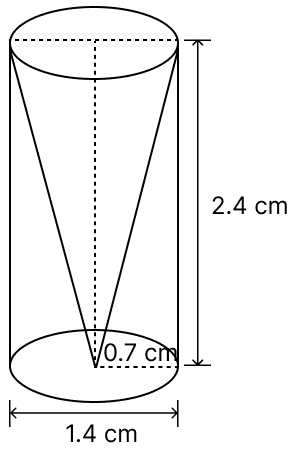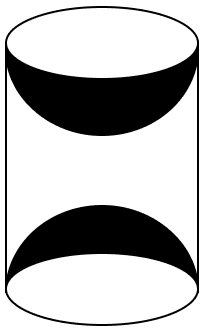Mathematics
From a solid cylinder whose height is 2.4 cm and diameter 1.4 cm, a conical cavity of the same height and same diameter is hollowed out. Find the total surface area of the remaining solid to the nearest cm2.
Mensuration
15 Likes
Answer
Given,
Diameter of solid cylinder (d) = 1.4 cm
Radius of solid cylinder (r) = = 0.7 cm.
Height of cylinder (h) = 2.4 cm
Height of conical cavity = Height of cylinder = h = 2.4 cm.

From figure,
Radius of conical cavity = Radius of cylinder = r = 0.7 cm.
By formula,
Slant height of cone (l) =
Substituting value we get :
Total surface area of remaining solid = Curved surface area of cylinder + Curved surface area of cone + Base area of cylindrical portion
Substituting values we get :
Total surface area of remaining solid = 2πrh + πrl + πr2
= πr(2h + l + r)
= x 0.7 x (2 x 2.4 + 2.5 + 0.7)
= 22 x 0.1 x (4.8 + 2.5 + 0.7)
= 2.2 x 8
= 17.6 ≈ 18 cm2
Hence, the total surface area of the remaining solid = 18 cm2.
Answered By
11 Likes
Related Questions
A medicine capsule is in the shape of a cylinder with two hemispheres stuck to each of its ends. The length of the entire capsule is 14 mm and the diameter of the capsule is 5 mm. Find its surface area.

A tent is in the shape of a cylinder surmounted by a conical top. If the height and diameter of the cylindrical part are 2.1 m and 4 m respectively, and the slant height of the top is 2.8 m, find the area of the canvas used for making the tent. Also, find the cost of the canvas of the tent at the rate of ₹ 500 per m2. (Note that the base of the tent will not be covered with canvas.)
A wooden article was made by scooping out a hemisphere from each end of a solid cylinder, as shown in the figure. If the height of the cylinder is 10 cm, and its base is of radius 3.5 cm, find the total surface area of the article.

A solid is in the shape of a cone standing on a hemisphere with both their radii being equal to 1 cm and the height of the cone is equal to its radius. Find the volume of the solid in terms of π.